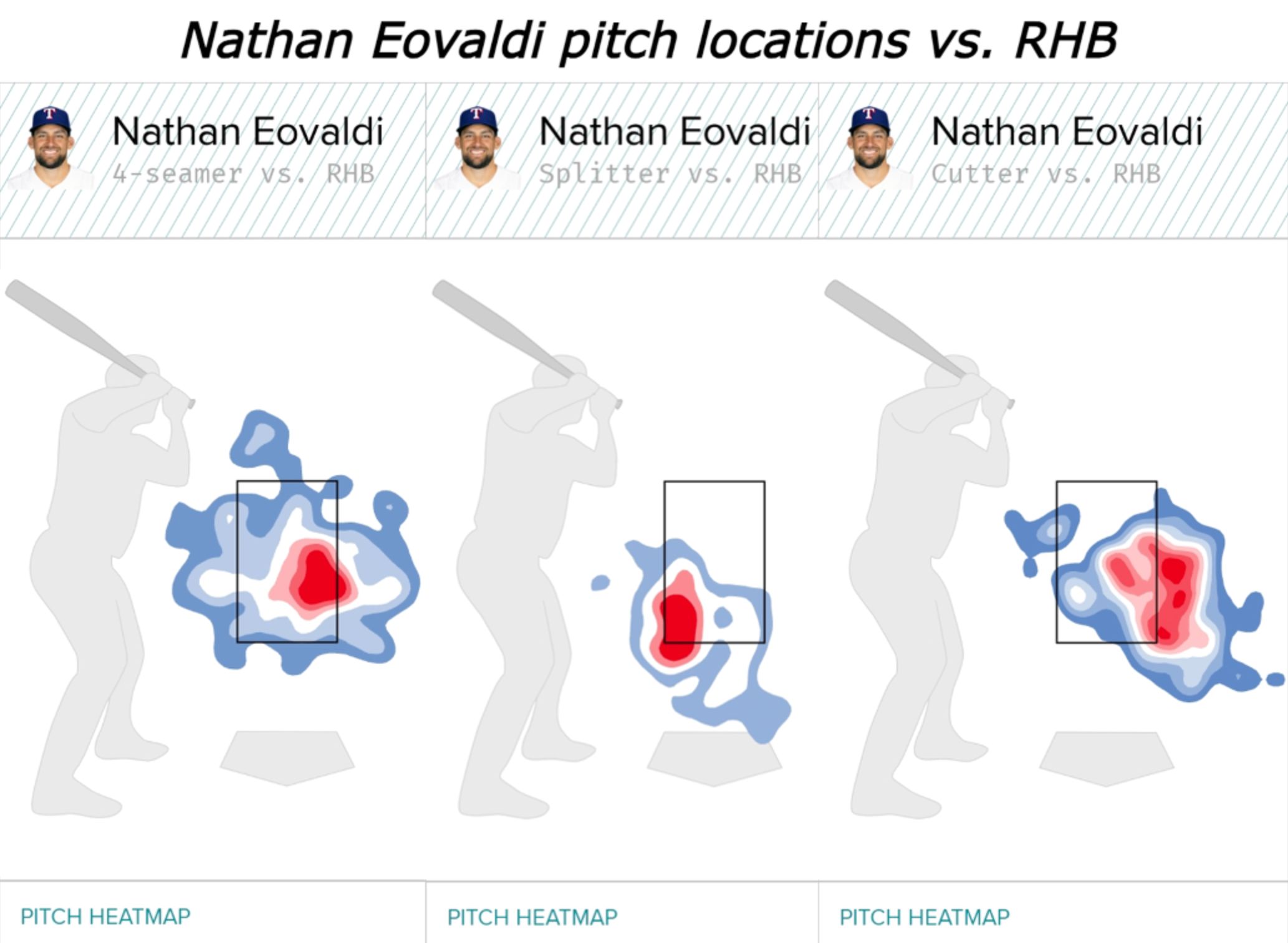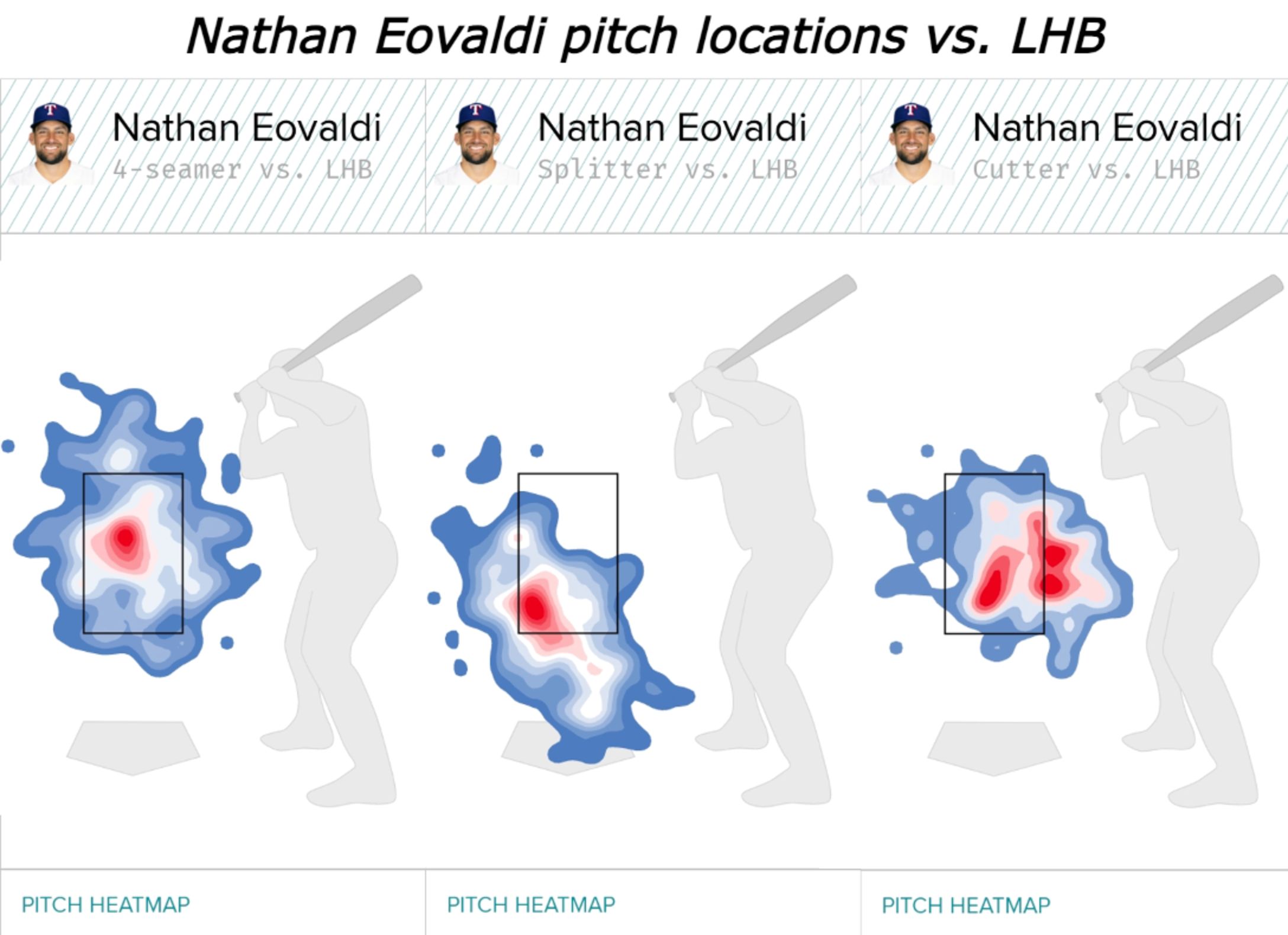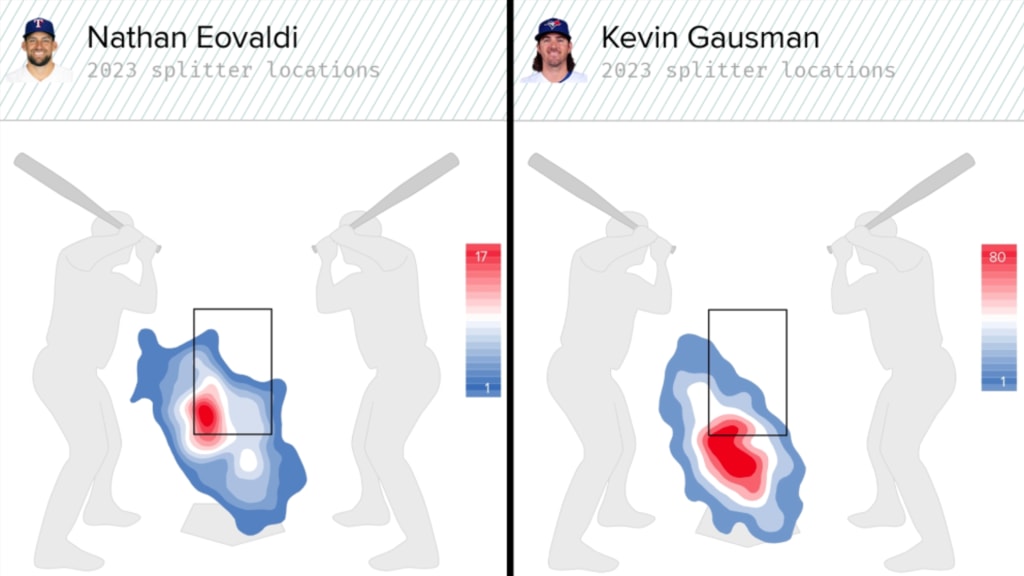What Nathan Eovaldi is doing for the Rangers is more important than ever, with Jacob deGrom injured and Texas theoretically missing an ace -- if Eovaldi hadn't emerged as one of the top workhorses in the league.
Here's how he's getting it done. And it's maybe not how you'd expect.
Look at Eovaldi's stuff, and you might expect him to attack hitters like a traditional power pitcher: blow his upper-90s fastball past them upstairs, then drop his secondary pitches down underneath it, straight through the bottom of the zone.
But that's not how he pitches. Eovaldi works side to side across the strike zone, and that's the key to his success this season. As he takes a 2.24 ERA into his start Saturday against the MLB-best Rays, the veteran right-hander is commanding the inside and outside edge of the plate like nobody else.
Here's where Eovaldi locates his most important pitches vs. right-handed and left-handed hitters: his four-seamer, his splitter and his cutter.


It's a lot more about going in and out than going up and down.
Eovaldi pounds the outside edge of the plate with his fastball no matter who he's facing -- he's also more than willing to go inside, especially for a strikeout -- then he keeps his splitter on the left edge of the plate (from the hitter's point of view) and his cutter on the right edge of the plate.
"Classic Nate when he’s really on top of it," Yankees manager Aaron Boone said after Eovaldi dismantled the Bronx Bombers lineup for his first career nine-inning shutout on April 29. "He kind of bullied us. He used both sides of the plate … obviously [with] the cutter and the split. And stuff-wise, he was throwing hard."
And Eovaldi's approach makes perfect sense when you consider how his stuff plays.
His four-seamer isn't a rising fastball, it's a running fastball. Eovaldi still has excellent velocity, averaging about 96 mph and touching 99 mph this season, but he doesn't get the vertical carry through the strike zone that some other aces with big fastballs have, like a Spencer Strider or Gerrit Cole.
What it does have is great arm-side movement. Eovaldi's fastball averages 13 inches of horizontal break, four inches more than an average four-seamer.
So Eovaldi doesn't try to overpower every hitter with high heat à la Strider or Cole. Instead, Eovaldi runs his fastball onto the edges of the strike zone, where he can pair it with his other pitches, especially his splitter and cutter.
Eovaldi's splitter and cutter have similar velocity -- the cutter averages 91 mph, the splitter averages 88 mph -- but, of course, the cutter breaks to his glove side and the splitter fades to his arm side. So he lets the pitch's movement take it to its location: He cuts the cutter onto the glove-side edge of the plate, and he runs the splitter onto the arm-side edge.
"That’s one of the nice things about having the cutter, is I’m able to stick that in there with the splitter and get some early outs," Eovaldi said after throwing his second complete game of the season on May 23.
His divide-and-conquer approach to the strike zone is possible because Eovaldi's splitter is a running pitch more than a dropping pitch -- just like how his fastball is a running fastball and not a rising fastball. His splitter drops, yes, but it also averages 14 inches of horizontal break, much more than, say, Shohei Ohtani, whose trademark splitter has more true vertical movement.
A lot of pitchers who feature a fastball/splitter combo work vertically, like Ohtani and Kevin Gausman, whose splitters are almost always a chase pitch below the zone. Eovaldi works horizontally; his splitter is an attack pitch on the outside part of the plate, in the zone at one of the highest rates among splitter users.

Eovaldi's fastball/splitter/cutter trio gives him a balanced attack to get hitters out -- each of those pitch types have accounted for a meaningful share of his runs prevented this season.
It all depends how he wants to attack a hitter in tandem with his heater. If he wants to go away, Eovaldi can throw the cutter off the outside edge to a righty, while his fastball will run back onto the corner, or hammer the low-outside corner with his splitter to a lefty after setting him up with a heater that has the same movement track but much different velocity. If he wants to go in, Eovaldi can run the splitter down-and-in under a righty's wrists, or bust a lefty with a cutter on the hands.
"He's just not afraid of anything," A's catcher Shea Langeliers said of Eovaldi after he shut down Oakland to reach a scoreless streak of 28 2/3 innings. "He's going to come straight at you."
Eovaldi's ability to locate his three big pitches on the edges of the zone, and suppress offense by pitching to the edges, is among the best in baseball.
Eovaldi hits the edges at a high rate -- about 45% of his pitches are within a baseball's width of the strike zone borders -- and he's extremely successful when he hits those spots. Based on the results of all the pitches he's thrown there, Eovaldi has been the second-best pitcher in the Majors at preventing runs by pitching to the edges of the zone.
Top pitchers by run value on the edges of the zone, 2023
1. Merrill Kelly: 21 runs prevented
2. Nathan Eovaldi: 19 runs prevented
3. (tie) Marcus Stroman, Logan Webb: 18 runs prevented
5. (tie) Luis Castillo, Shane Bieber, Jack Flaherty, Edward Cabrera: 17 runs prevented
When Eovaldi is commanding the edges with his full arsenal, he can roll through opposing lineups, eat innings and keep runs off the board. He doesn't need to overpower the world like deGrom to be an ace like him.
